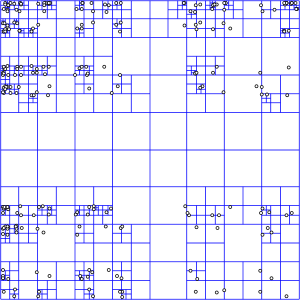clj-quad
Clj-quad is a purely functional implementation of the Quadtree data structure. Quadtrees are commonly used for spatial partitioning of two dimensional space for fast lookup of elements based on location. As elements are inserted into the tree, the tree subdivides recursively into four quadrants until a specified maximum depth is reached. This essentially means that every time a fifth elements is inserted into a quadrant the quadrant is subdivided into four child quadrants and the child elements are redistributed.

This structure allows for fast look up and retrieval of elements based on location and/or area. This is especially beneficial for tasks like collision detection on many shapes. This library is directly inspired by Mike Chambers' post and javascript implementation. Clj-quad provides a purely functional Quadtree through the use of the clojure zipper library.
Clj-quad is compatible with both Clojure and Clojurescript.
Note: This library is very much in beta so changes are likely.
Usage
[clj-quad "0.1.0-beta"]
Creation
Create a new quadtree with a specified dimension.
=> (def quad
(quadtree
{:depth 0
:bounds
{:x 0 :y 0 :width 1000 :height 1000}
:nodes []}))
=> (pprint quad)
[{:bounds {:width 1000, :y 0, :x 0, :height 1000},
:children [],
:step-children [],
:nodes [],
:max-depth 4,
:max-children 4,
:depth 0}
nil]
Insertion
Create some elements to insert
=> (def elements [{:bounds {:x 50 :y 100 :width 10 :height 5}}
;; or use the bounds function
{:bounds (bounds 200 150 8 8)}
{:bounds (bounds 200 800 8 8)}
;; or the rect helper function
(rect 790 434 8 8)
(rect 346 124 8 8)
(rect 15 900 8 8)])
Insert single elements with insert or a seq of elements with insert-children
=> (insert quad {:bounds (bounds 200 800 8 8)})
[{:bounds {:width 1000, :y 0, :x 0, :height 1000},
:children [{:bounds {:x 200, :y 800, :width 8, :height 8}}],
:step-children [],
:nodes [],
:max-depth 4,
:max-children 4,
:depth 0}
nil]
nil
=> (insert-children quad elements)
[{:bounds {:width 1000, :y 0, :x 0, :height 1000},
:children (),
:step-children [],
:nodes
({:bounds {:x 0, :y 0, :width 500, :height 500},
:children
[{:bounds {:width 10, :y 100, :x 50, :height 5}}
{:bounds {:x 200, :y 150, :width 8, :height 8}}
{:bounds {:x 346, :y 124, :width 8, :height 8}}],
:step-children [],
:nodes [],
:max-depth 4,
:max-children 4,
:depth 1}
{:bounds {:x 500, :y 0, :width 500, :height 500},
:children [{:bounds {:x 790, :y 434, :width 8, :height 8}}],
:step-children [],
:nodes [],
:max-depth 4,
:max-children 4,
:depth 1}
{:bounds {:x 0, :y 500, :width 500, :height 500},
:children
[{:bounds {:x 200, :y 800, :width 8, :height 8}}
{:bounds {:x 15, :y 900, :width 8, :height 8}}],
:step-children [],
:nodes [],
:max-depth 4,
:max-children 4,
:depth 1}
{:bounds {:x 500, :y 500, :width 500, :height 500},
:children [],
:step-children [],
:nodes [],
:max-depth 4,
:max-children 4,
:depth 1}),
:max-depth 4,
:max-children 4,
:depth 0}
nil]
Retrieval
Given a tree and a map of position and dimensions, clj-quad will return a list of elements in the relevant quadrant.
Retrieve elements from a quad based on a point
=> (retrieve-point quad (point 100 100))
({:bounds {:width 10, :y 100, :x 50, :height 5}}
{:bounds {:x 200, :y 150, :width 8, :height 8}}
{:bounds {:x 346, :y 124, :width 8, :height 8}})
or retrieve elements based on a rectangle
=> (retrieve-rect quad (rect 100 100 600 600))
({:bounds {:width 10, :y 100, :x 50, :height 5}}
{:bounds {:x 200, :y 150, :width 8, :height 8}}
{:bounds {:x 346, :y 124, :width 8, :height 8}}
{:bounds {:x 790, :y 434, :width 8, :height 8}}
{:bounds {:x 200, :y 800, :width 8, :height 8}}
{:bounds {:x 15, :y 900, :width 8, :height 8}})
In the future paths will be supported as well as primitive shape areas.
Feel free to use or modify please just share improvements.
Road map
- Child updates
- Utility functions for collision detection
- Support for path intersection
License
Copyright © 2013 Jon Rose
Distributed under the Eclipse Public License, the same as Clojure.
Can you improve this documentation?Edit on GitHub
cljdoc is a website building & hosting documentation for Clojure/Script libraries
× close